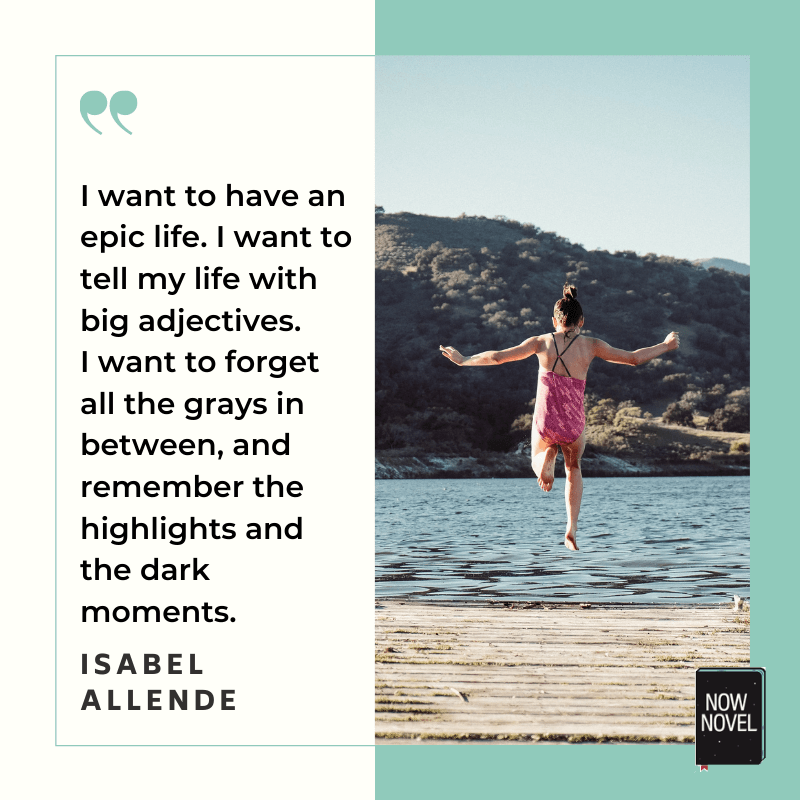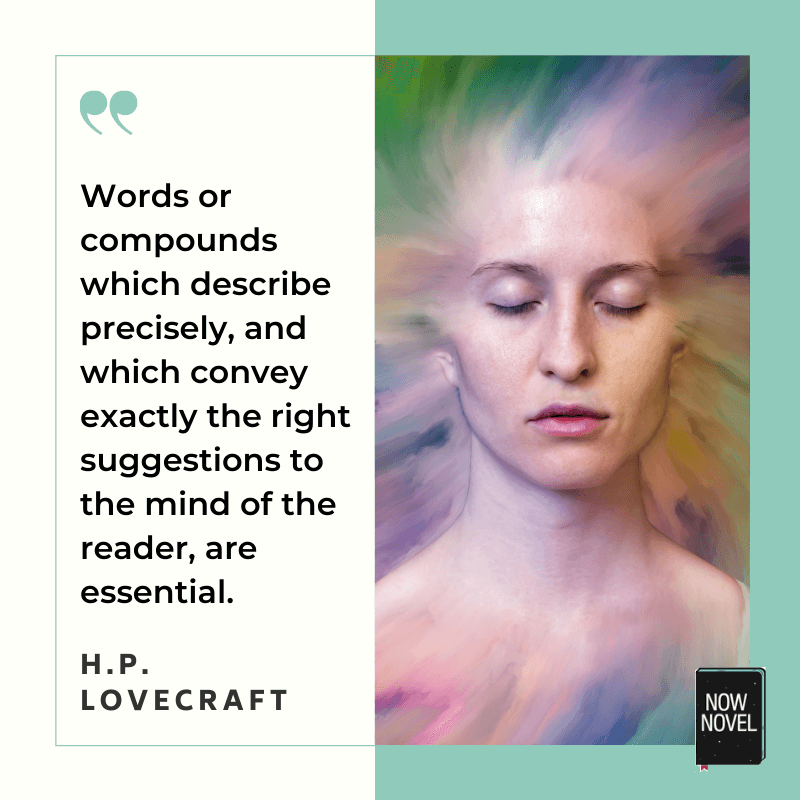Finding the right adjectives for description is tough. Try these 7 tips, and create your own describing word dictionary:
What is an adjective?
Adjectives are parts of speech used to modify nouns. They describe and make people and things more specific.
How do you identify an adjective? It typically appears right before the noun it describes. A tiny speck. A dazzling supernova.
Descriptive adjectives tell us what kind of person or object we’re looking at. They add specificity, giving shape, size, age, or other attributes.
Limiting adjectives tell us a noun’s quantity or a restriction about it. For example:
- That speck is tiny (the adjective makes it clear we are referring to a particular speck and not another)
- Three supernovas changed our understanding of space (out of all the supernovas ever, three are specified by the adjective).
This article focuses primarily on descriptive adjectives.
How to write punchy adjectives for description:
- Replace ‘very + adjective’
- Know connotations
- Note dazzling descriptions
- Find adjectives in metaphor
- Remember assonance and alliteration
- Find adjectives for description by origin
- Keep a list of strong adjectives handy
Let’s explore these description tips further:
1. Replace ‘very + adjective’
‘Very’ is useful to a point. If we say ‘the very small turtle’, we know we’re not reading about giant Galapagos ones.
Children often describe things using ‘very’ because it’s easier vocabulary we learn young.
In a story – even one for children – too much ‘very + adjective’ gets boring. Why? Because it lacks variety and specificity.
Consider these ‘very + adjective’ pairs and their alternatives:
Adjectives better than ‘very + word’
| Very + adjective | Alternative word | Root Meaning/Origin |
| very small | minute | ‘made small’ |
| very fast | swift | ‘move in a course, sweep’ |
| very rude | obnoxious | ‘exposed to harm’ |
| very beautiful | exquisite | ‘sought out’ |
The four examples above show the benefits of replacing ‘very + adjective’. Specific connotations, concision and precision.
2. Know connotations
Examining adjectives shows how subtle language is.
For example, compare ‘very beautiful’ and ‘exquisite’.
‘Very beautiful’ tells a reader well enough that a person or thing is visually appealing.
‘Exquisite’, though, implies qualities of rarity and demand in the root Latin origin of ‘sought out’.
We might write of an ‘exquisite necklace‘. The reader is able to picture it in a shop window, tantalizing passersby.
This is why it’s useful to examine words’ connotations.
Comparing adjectives helps, too.
For example, the difference between exquisite (sought after) and stunning (a beauty able to cause astonishment).

3. Note dazzling descriptions
A simple way to become skilled at finding the right adjective is to collect your favourites.
When you’re reading and a description leaps out at you, write it down.
Let’s read, for example, Kent Haruf’s description of two aged brothers:
In the kitchen they removed their hats and hung them on pegs set into a board next to the door and began at once to wash up at the sink. Their faces were red and weather-blasted below their white foreheads, the coarse hair on their round heads grown iron-gray and as stiff as the roached mane of a horse.
Kent Haruf, Eventide (2004), p. 3 (our emphasis).
Note how rich Haruf’s intro to the McPheron brothers is.
The adjectives Haruf chooses for description mix simple colours (red and white) with more complex ones. The complex adjectives involve comparison (‘iron-gray’, ‘stiff as the roached mane of a horse’).
These are paired with qualities suggesting hard living (‘weather-blasted’, ‘coarse’).
Try to mix simple adjectives with more complex ones. The reds and whites with the iron-grays and custard yellows of life. Find more description examples in our guide to descriptive writing.
4. Find adjectives in extended metaphor
This is a more advanced technique for crafting description out of a shared metaphor.
Using extended metaphors: Toni Morrison’s Song of Solomon
Early in the novel, we read a vivid description of the tough father of the house, Macon Dead:
Solid, rumbling, likely to erupt without prior notice, Macon kept each member of his family awkward with fear. His hatred of his wife glittered and sparked in every word he spoke to her. The disappointment he felt in his daughters sifted down on them like ash, dulling their buttery complexions and choking the lilt out of what should have been girlish voices.
Toni Morrison, Song of Solomon (1977), pp. 10-11
The description compares Macon to a volcano (‘likely to erupt without prior notice’).
Note how Morrison looks for descriptive phrases in the same metaphorical neighborhood.
Her description is varied because Morrison uses some adjectives, but also metaphorical, verbal phrases. ‘Sifted down on them like ash’, to describe the constant raining down, discomfort, of Macon’s disappointment.
This variety carries the description along.
Standard adjectives include:
- Solid (describing Macon’s stature)
- Awkward (describing the discomfort Macon creates in his family)
- Buttery (describing his daughters’ complexions)
- Girlish (describing a quality Macon’s daughters’ voices would have had, if not for his toughness)
Yet Morrison also includes describing words in the form of verbs. She describes the way Macon’s hatred ‘glittered’ and ‘sparked’ (extending the volcano metaphor).
The result? A paragraph alive with vivid and varied imagery and action, yet cohesive, too.
5. Remember assonance and alliteration
Assonance and alliteration are useful poetic devices to remember for descriptions.
Assonance is the repetition of vowel sounds. For example, the repeated ‘ay’ in ‘We lay, aimless, waiting for that hazy summer’s cooling.’
Here, the sound’s repetion creates a languid, lazy feeling.
Alliteration is the repetition of consonants.
For example, the repetition of sharp plosive ‘t’ and ‘p’ sounds in Wilfred Owen’s famous war poem, ‘Anthem for Doomed Youth’. The sounds mimic gunfire:
What passing-bells for these who die as cattle?
Wilfred Owen, ‘Anthem for Doomed Youth’, available on Poetry Foundation here.
— Only the monstrous anger of the guns.
Only the stuttering rifles’ rapid rattle.
When choosing adjectives for description, try reading the sentence aloud. How does it sound?

6. Find adjectives for description by origin
If you look back at the list of words to replace ‘very + adjective’, you see the words’ given origins.
Etymology (the origin of words) is a gift for crafting great description.
Look up adjectives’ root origins when unfamiliar. You may be surprised by the subtle meanings the right adjectives add.
7. Keep a strong list of adjectives handy
Build your own descriptive encyclopedia.
For example, here are 60 adjectives for descriptions, organised by category:
Adjectives for describing size, age, character and more
| Adjective | Definition |
| microscopic | so small as to be only visible with a microscope |
| gargantuan | enormous |
| infinitesimal | immeasurably or incalculably small |
| miniscule | extremely small or tiny |
| massive | forming or consisting of a large mass, having great size and weight or solidity |
| ancient | belonging to the very distant past |
| archaic | very old or old-fashioned |
| primordial | existing at or from the beginning of time |
| fresh | (of food) recently made or obtained, not previously known or used |
| novel | interestingly new or unusual |
| lustrous | having lustre or shining |
| brilliant | (of light or colour) very bright |
| sparkling | shining brightly with flashes of light |
| glittering | shining with a shimmering or sparkling light |
| dull | lacking bightness, vividness or sheen, not sharp |
| acute | (unpleasant) present or experienced to a severe or intense degree. |
| honed | (of a blade), sharpened, having been refined or perfected |
| precise | (of a person) exact, accurate, and careful about details |
| blunt | (of a person or remark) uncompromisingly forthright |
| edgy | tense, nervous, irritable |
| foul | offensive to the senses, especially through having a disgusting smell or taste or being dirty |
| putrid | (of organic matter) decaying or rotting and emitting a fetid smell |
| aromatic | having a pleasant and distinctive smell |
| fragrant | having a pleasant or sweet smell |
| perfumed | naturally having or producing a sweet, pleasant smell |
| delectable | (of food or drink) delicious |
| delicious | highly pleasant to the taste |
| mouth-watering | arousing the appetite : tantalizingly delicious or appealing |
| bitter | having a sharp, pungent taste or smell; not sweet |
| acrid | unpleasantly bitter or pungent |
| benevolent | well meaning and kindly |
| benign | gentle and kind |
| genial | friendly and cheerful |
| belligerent | hostile and aggressive |
| solicitous | characterized by or showing interest or concern |
| uppity | self-important, arrogant |
| blithe | showing a casual and cheerful indifference considered to be callous or improper |
| dour | relentlessly severe, stern, or gloomy in manner or appearance |
| obstinate | stubbornly refusing to change one’s opinion or chosen course of action |
| fickle | changing frequently, especially as regards one’s loyalties or affections |
| fastidious | very attentive to and concerned about accuracy and detail |
| pedantic | excessively concerned with minor details or rules; overscrupulous |
| stingy | mean; ungenerous |
| bellicose | demonstrating aggression and willingness to fight |
| po-faced | having an assumed solemn, serious, or earnest expression or manner |
| arch | deliberately or affectedly playful and teasing |
| coy | making a pretence of shyness or modesty which is intended to be alluring, reluctant to give details |
| insouciant | showing a casual lack of concern |
| unscrupulous | having or showing no moral principles; not honest or fair |
| pragmatic | dealing with things sensibly and realistically in a way that is based on practical rather than theoretical considerations |
| cerulean | deep blue in colour like a clear sky |
| mottled | marked with spots or smears of colour |
| variegated | exhibiting different colours, especially as irregular patches or streaks |
| kaleidoscopic | having complex patterns of colours; multicoloured |
| saturated | (of colour) very bright, full, and free from an admixture of white. |
| elated | very happy or proud; jubilant; in high spirits |
| glum | looking or feeling dejected; morose |
| chipper | cheerful and lively |
| sanguine | optimistic or positive, especially in an apparently bad or difficult situation |
| gleeful | exuberantly or triumphantly joyful |
Develop your descriptions with the help of fun exercises and examples. Get How to Write Real Characters: Character Description, a practical workbook with exercises and supplementary videos.


4 replies on “Adjectives for description: 60 precise words”
An excellent post on adject and how to best use them. I’m bookmarking this for future reference.
Thank you, Viv! Thanks for reading and for the kind feedback on our blog.
I’m new at writing a book. This helped me a lot to create better dialogs expressing emotions…something I’ve been having trouble with.
Dear Florencia,
That’ great to hear! Glad you’ve found the blog post so useful. Writing punchy adjectives that add sparkle and zing to a story is so important. The blog post lists a whole lot of adjectives for describing size, age, character and more.